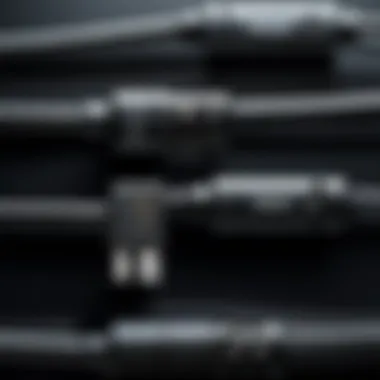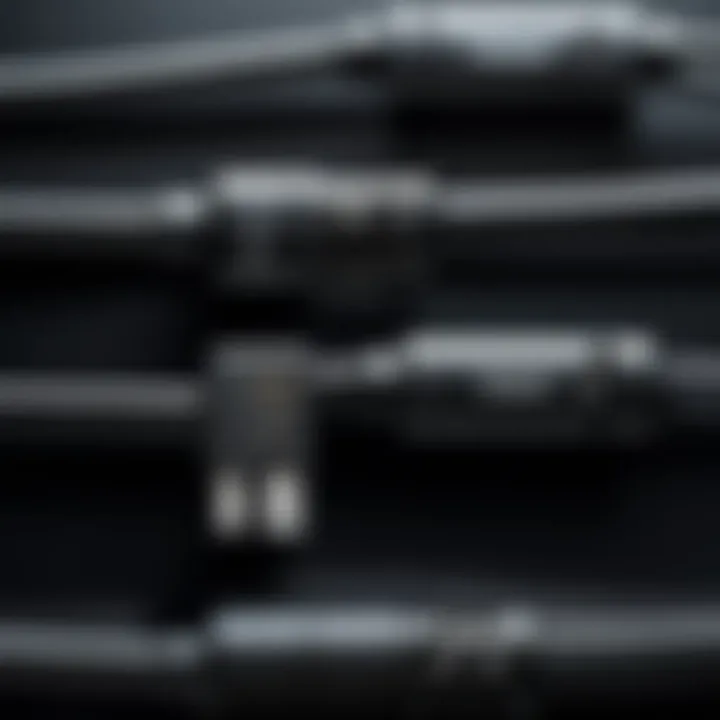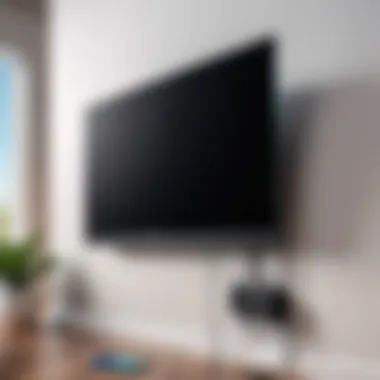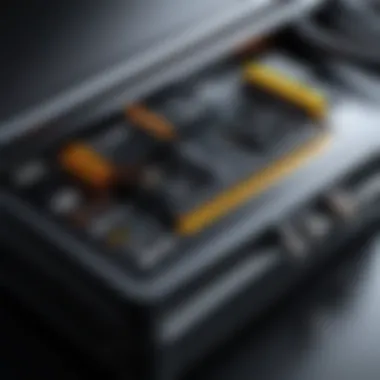Choosing the Best Extension Cord for Wall-Mounted TVs


Intro
In modern homes, a wall-mounted television is a popular choice. It saves space and creates a clean look. However, installation comes with challenges, especially when it comes to power requirements. Choosing the right extension cord to connect the TV can significantly impact functionality and safety. This guide delves into the essentials for selecting an extension cord suited for wall-mounted installations. We will take a look at product features, specifications, and buying tips, ensuring a comprehensive understanding.
Product Overview
Brief Description
An extension cord designed for wall-mounted TVs allows you to connect your television and related devices away from the wall outlet. These cords vary in length, power capacity, and safety features. It is essential to select the right type to prevent hazards like overheating or electrocution.
Key Features
When choosing an extension cord, consider the following key features:
- Power Rating: Ensure the cord supports the wattage required by your TV and accessories.
- Length: Opt for a length that provides flexibility in positioning without excess slack.
- Surge Protection: Consider cords with built-in surge protectors to safeguard electronics from voltage spikes.
- Flat Design: Some extension cords come with a flat profile, making them easier to install along walls.
Available Variants
Different types of extension cords can be found on the market:
- Basic Extension Cords: Simple and unprotected, suitable for low-wattage devices.
- Surge Protector Cords: Equipped with surge protection to shield electronics against power surges.
- Power Strips: Multiple outlets with built-in surge protection, ideal for connecting several devices.
Specifications Breakdown
Technical Specifications
When evaluating an extension cord, pay attention to the technical specifications:
- Gauge Size: Lower gauge number indicates a thicker cord, which can handle more power.
- Voltage Rating: Ensure it meets the needs of your devices, usually rated at 120V for common appliances.
Performance Metrics
Look for the following performance metrics:
- Amp Rating: Indicates the maximum current the cord can safely carry.
- Fire Resistant Material: It is essential that the cord is made from materials that do not easily catch fire.
Compatibility Information
Ensure that the extension cord is compatible with your specific TV model and any other connected devices. Check the manufacturer's documentation for guidance.
Comparative Analysis
Competing Products
There are several notable extension cords available. Analyzing differences can help determine the best fit.
Strengths and Weaknesses
While some cords are exceptionally durable with high power ratings, others may integrate advanced features such as multiple outlets but may be less resilient. Evaluating these aspects is crucial.
Price Comparison
Prices vary based on features and quality. Basic cords may start at $10, while advanced surge protector cords may reach $50 or more. Evaluate your needs against your budget.
Buying Guide
Target User Profiles
Target audiences for wall-mounted TV extension cords include:
- Tech Enthusiasts: Seek high-quality and feature-rich cables.
- Gamers: Look for cords that can handle high power demands.
- DIY Builders: Need flexible options for custom installations.
Important Considerations
Before buying,
- Determine how many devices will connect.
- Decide on the cord length based on layout.
- Always prioritize safety features over price.
Insider Tips for Buyers
- Read reviews from credible sources to gauge reliability.
- Ensure the cord complies with relevant safety standards, such as Underwriters Laboratories (UL) certification.


Maintenance and Upgrade Insights
Regular Maintenance Practices
Periodically check for wear or damage. Ensure connections are tight and do not use cords that show signs of fraying.
Upgrade Paths and Options
If you require more power or additional outlets, consider upgrading to a higher capacity cord or a power strip. This improves both convenience and safety.
Troubleshooting Common Issues
If your devices fail to power on or show signs of faults, check for issues with the cord like frays or loose connections. Avoid using worn cords, and replace them as necessary.
Safety Reminder: Always prioritize safety when dealing with electrical components to protect personal and home safety.
Understanding Extension Cords
Extension cords play a significant role in today’s tech-driven world. They bridge the gap between fixed power sources and our diverse electronic devices, especially in scenarios where outlets are either scarce or inconveniently located. This holds particularly true for wall-mounted televisions, where accessibility and safety need to be carefully balanced. In this section, we will delve into the core aspects of extension cords, exploring their utility, features, and ideal usage situations relevant to a well-organized and functional home theater setup.
Definition and Purpose
An extension cord is essentially a flexible electrical power cable that extends the reach of a power source. It typically consists of a plug on one end for connection to a standard electrical outlet, and one or more sockets on the other to accommodate numerous devices. The primary purpose of an extension cord is to provide additional outlets when the existing configuration does not meet the demands of the appliances in use.
For wall-mounted TVs, using the right extension cord is essential. Not only does it allow for proper placement of the TV at a comfortable viewing height, but it also minimizes clutter and keeps cords out of sight. This enhances both the aesthetic of the room and the safety of the setup, reducing the risk of accidental tripping over loose cables.
Common Usage Scenarios
Extension cords are used in various contexts, making them an indispensable tool in modern electricity management. Below are a few common scenarios:
- Home Entertainment Systems: Many individuals use extension cords to connect TVs, sound systems, and gaming consoles, particularly when outlets are not conveniently located.
- DIY Projects: Enthusiasts often rely on extension cords to power tools during home improvement tasks, providing versatile access to electricity in workshops or garages.
- Office Spaces: In work-from-home environments, extension cords serve as solutions for devices in need of power beyond the reach of wall outlets.
- Events and Gatherings: Whether it’s for outdoor events or indoor parties, extension cords are there to supply power to lighting, audiovisual setups, or food preparation areas.
Importance of Extension Cord Safety
Extension cords play a crucial role in connecting electronic devices, especially for wall-mounted televisions. Ensuring safety while using these cords is essential. Poor choices can lead to hazards such as electrical fires or damage to devices. This section explores the importance of extension cord safety, emphasizing key elements and benefits that must be considered.
Electrical Safety Standards
Electrical safety standards are regulatory measures that ensure devices are safe for public use. They dictate how extension cords are designed, manufactured, and tested. These standards vary by region but generally cover aspects like material quality and performance under different conditions. For instance, the National Electrical Code (NEC) in the United States outlines guidelines to prevent accidents.
When selecting an extension cord, it is imperative to check for certification marks such as UL (Underwriters Laboratories) or ETL (Edison Testing Laboratories). These indicate that the product meets stringent safety regulations. Choosing products that comply with standards helps ensure they can handle the voltage and current they will be subjected to. Additionally, it decreases the chance of accidents due to faulty equipment.
Risks of Overloading
Overloading an extension cord is a significant risk that can lead to dangerous situations. An extension cord has a specific capacity measured in amperes. Exceeding this limit can cause the cord to overheat, potentially leading to melting or fire.
A few common scenarios that lead to overloading include:
- Connecting multiple high-wattage devices, such as televisions, gaming consoles, and sound systems, to one extension cord.
- Using an extension cord that is not rated for the specific power needs of the devices.
- Long-term use of inadequately rated cords that are intended for light-duty tasks.
To minimize this risk, it's essential to:
- Calculate the total wattage of devices intended to be powered.
- Select an extension cord that can handle 20% more than the calculated load.
- Monitor the cord during use, ensuring it does not become excessively hot.
Regularly evaluating the capacity of your extension cord ensures a safer environment for all your electronic devices.
In summary, understanding electrical safety standards and the risks of overloading is vital when using extension cords for wall-mounted TVs. Prioritizing these considerations leads to a safer and more effective setup.
Types of Extension Cords
Choosing the right extension cord for a wall-mounted TV is a crucial aspect that can significantly impact your setup. It is essential to understand the various types of extension cords available in the market. Each type has its own specifications, benefits, and limitations. Knowing these distinctions helps in making an informed choice that suits specific needs, safety standards, and electrical requirements.
Standard vs.
Heavy-Duty
Standard extension cords are generally designed for light to moderate usage. They typically feature a lower gauge wire, suitable for powering smaller devices such as lamps or chargers. Most standard cords have a maximum wattage that they can safely handle, which variant depending on the length and gauge of the cord.
On the other hand, heavy-duty extension cords utilize thicker gauge wires. These are meant for more demanding appliances, such as televisions and gaming systems, which may require a consistent and robust power supply. Heavy-duty cords minimize the risk of overheating and potential fire hazards, making them a safer choice for wall-mounted TVs that often draw more power. Selecting a heavy-duty option is prudent, especially if multiple devices are connected.
Cord Length and its Implications
Cord length is another vital factor to consider when choosing an extension cord. While longer cords offer flexibility in installation, they also come with inherent drawbacks. Longer extension cords may experience voltage drop, which can lead to inefficient power delivery. For devices like wall-mounted TVs, this could mean subpar performance or even potential damage over time.


It is wise to measure the distance from the power outlet to the TV location before making a decision. As a rule of thumb, it's best to use the shortest cord that satisfies your needs. This approach reduces risk and ensures that the necessary power reaches your devices effectively. Aim for a cord that offers a balance between length and efficiency.
Flat Extension Cords for Wall Mounting
Flat extension cords are an increasingly popular option for wall-mounted TVs. These cords are designed to fit snugly against walls, which helps in reducing the visual clutter that often accompanies traditional round cords. Their streamlined design allows for easier cable management, making them an aesthetically pleasing solution.
Flat cords often have multiple outlets, allowing for connectivity of several devices without causing tangles or excess dangling lengths. When installing in tight spaces, flat extension cords can be an optimal choice, as they facilitate more organized and concealed setups. However, ensure that any selected flat cord meets safety standards necessary for the wattage and voltage of your specific devices. This consideration ensures that practical design does not compromise safety.
Important Note: Always look for cables with appropriate certifications to ensure they meet safety regulations.
In summary, understanding the types of extension cords available is essential for a safe and efficient setup for a wall-mounted TV. Each type serves specific needs, and careful selection can enhance both functionality and safety in your home entertainment system.
Key Features to Consider
When choosing an extension cord specifically for a wall-mounted TV, several key features must be evaluated to ensure optimal performance and safety. These features not only enhance user experience but also protect expensive electronic devices from potential hazards. Focusing on the right features can also help in avoiding inconveniences and ensuring a smooth installation process.
Surge Protection
Surge protection is a very crucial feature in an extension cord, especially for devices that are sensitive to voltage fluctuations, such as televisions. A power surge can occur due to various factors like lightning strikes, faulty wiring, or utility switchovers. Without surge protection, a sudden spike in voltage can severely damage the electronic components of your TV. Therefore, investing in an extension cord equipped with surge protection is advised.
Surge protectors function by diverting excess voltage away from connected devices. This capability safeguards electronic equipment against destructive electrical shocks. When choosing an extension cord, look for one with a higher Joule rating, as this indicates better protection. Generally, a surge protector with a rating of 1000 Joules or more is recommended for most home electronics, but for a wall-mounted TV, consider going higher to cover sudden spikes.
Built-in Circuit Breakers
Another important feature to consider is the presence of built-in circuit breakers. Circuit breakers automatically interrupt the power flow when they detect an overload or short circuit. They serve as a safety measure that prevents overheating and potential fire risks. In wall-mounted setups, where cords may be less accessible, having a circuit breaker is even more essential. This feature allows users to protect their equipment without having to constantly check for potential issues.
When examining circuit breakers, note the ampage rating of the cords and match it with the power requirements of your TV. The correct capacity prevents the breaker from tripping during normal use, while still offering protection when needed. Also, opt for cords with indicators that show when the breaker has triped. This alert ability ensures you are informed quickly and can address the issue without disrupting your TV usage extensively.
Number of Outlets
The number of outlets on an extension cord is often overlooked but is crucial for a well-organized entertainment space. Many wall-mounted TVs require multiple devices, such as streaming devices, sound systems, or gaming consoles, to function optimally. Hence, finding an extension cord with a suitable number of outlets is vital to avoid the hassle of having to buy additional cords later.
A standard extension cord usually comes with between two to six outlets. It is advisable to choose one that aligns with your current and potential future needs. Having a few additional outlets can also reduce cable clutter, especially important when mounting a TV on the wall. If there is a concern about overcrowding outlets and drawing too much power, consider devices that include built-in power strips or smart features that allow for better management of connected devices.
"Choosing the right features in an extension cord not only ensures safety but maximizes the functionality of your wall-mounted TV setup."
Installation Considerations
When setting up a wall-mounted TV, the selection and installation of an extension cord is critical. This not only affects aesthetics but also dictates the safety and functionality of your entire setup. Proper installation ensures that the cord does not become a hazard while also enhancing the overall viewing experience. A well-considered installation will prevent future issues down the line, such as overheating or connectivity problems.
Mounting Options for Extension Cords
Selecting the right mounting option for your extension cord involves examining various factors. One popular choice is to mount the cord directly behind the TV. This method keeps the extension cord hidden and minimizes visible clutter. It is often achieved by using cord management systems designed specifically for this task. However, ensure that the extension cord remains accessible for any future adjustments or replacement needs.
Another option is to route the extension cord along the wall. This can be done using adhesive clips or conduits. While this approach keeps the cord visible, it can still maintain a clean look if done neatly. Make sure to use clips that can hold the cord securely in place, preventing any potential tripping hazards.
Whichever mounting option you choose, be sure to avoid placing the cord near heat sources or areas prone to moisture. The goal is to ensure safety and functionality, managing the cord while keeping it hidden or visually appealing is a key aspect.
Cable Management Strategies
Effective cable management plays a vital role in maintaining an organized living area. Here are several strategies for managing your extension cord and ensuring a clean installation:
- Use cable ties: These can bundle multiple cords together, preventing tangles and making it easier to manage.
- Under-carpet paths: If you want a completely invisible setup, consider running your extension cord underneath floor coverings. This creates a seamless look, but ensure that it is the right cord for such installation to avoid overheating.
- Cable raceways: Use structured pathways to conceal cords against the wall. These can be painted to match your decor, making them less noticeable.
- Labeling: If you have multiple electronic devices connected, labeling your cords can help in troubleshooting and adjustments.
Properly managing your extension cord enhances not just safety but also the elegance of your overall setup.
Ultimately, installing and managing an extension cord appropriately is about balancing aesthetics, safety, and practicality. Taking these considerations seriously will result in a smoother functioning system and a more enjoyable viewing experience over time.
Compatibility with TV Models
Choosing the correct extension cord involves understanding how it interacts with various TV models. Compatibility with TV models is crucial for ensuring optimal performance and safety. Each TV has different power requirements based on its size, technology, and features. Therefore, any extension cord chosen must align with these specifications to maximize function and avoid hazards.
Assessing Power Requirements
When evaluating compatibility, start by assessing the power requirements of your television. Most TVs have a label on the back that indicates the wattage and voltage needed for operation. Generally, a standard flat-screen TV will require between 50 to 400 watts, depending on the size and technology used.
Using an extension cord that cannot handle the TV's power can lead to overheating and even electrical fires. It is advisable to use cords rated for at least 20% higher than the TV's power consumption. This ensures that, even during peak usage, the cord will work efficiently and safely.
As you assess your needs, keep in mind that smart TVs may have specific demands due to their additional features.
Considerations for Smart TVs
Smarter TVs often integrate advanced functionalities that can increase their power usage. Features like streaming capabilities, integrated voice assistants, and even built-in sound systems can draw more power than conventional TVs. For a wall-mounted setup, this means that not only should the extension cord meet the basic power requirements, but it must also accommodate any extra demands from these additional features.


A high-quality extension cord designed for electronics will often indicate compatibility with smart technologies. Look for cords with built-in surge protection or those that specify their suitability for higher-powered devices. This further enhances safety, ensuring that your investment in a smart TV goes unhampered by electrical issues.
Common Mistakes to Avoid
When selecting an extension cord for a wall-mounted TV, avoiding common mistakes becomes crucial. These missteps can lead to safety hazards, poor performance, and dissatisfaction with your setup. By understanding these pitfalls, you can make informed decisions that ensure a reliable and safe connection for your television.
Choosing the Wrong Cord Length
The length of an extension cord is often overlooked, yet it holds significant importance. Many users either choose a cord that is too short or excessively long. A cord that is too short may not reach the power outlet comfortably, leading to unsafe placement of devices. On the other hand, an excessively long cord can introduce voltage drops, affecting the performance of your TV. Ideally, measure the distance from your outlet to the intended place of your TV. This helps you select a cord that provides adequate reach while minimizing excess length.
“Using the right cord length is crucial to maintain electrical efficiency.”
When determining the necessary cord length, consider the layout of your room and the location of the outlets. Additionally, if you are wall-mounting your TV, be aware of where the cord will run. Clearance behind the TV can impact both aesthetics and functionality. In many cases, purchasing a cord that is slightly longer can be beneficial. It provides flexibility and reduces strain on the cord, which contributes to a safer setup.
Ignoring Voltage Compatibility
Another significant mistake is ignoring voltage compatibility between your TV and the extension cord. Every electrical device operates on a specific voltage, usually listed in the product manual or on the device itself. If you use an extension cord that does not match the voltage specifications, it could lead to malfunction or even damage your TV.
When shopping, always check the voltage rating of the extension cord against your television's requirements. This will help avoid scenarios where devices do not perform optimally or may risk overheating, potentially leading to fire hazards. In any case, always opt for cords that have appropriate safety certifications for your devices.
In summary, realizing the importance of length and voltage compatibility will significantly enhance the safety and efficiency of your installation. Making informed choices in these areas will ensure a smoother viewing experience.
Purchasing Tips
When selecting an extension cord for a wall-mounted TV, purchasing tips are vital. These tips help you navigate the market, ensuring you don’t just buy any cord, but the right one that meets your specific needs.
Choosing the correct extension cord goes beyond aesthetics. It involves understanding the technical specifications, safety standards, and compatibility with devices. In a world where electrical safety is paramount, being informed can save you effort, frustration, and potential hazards in the long run.
Where to Buy
Finding the right place to buy your extension cord is essential. You have several options:
- Local Electronics Stores: Stores like Best Buy or Fry's Electronics allow you to see the products firsthand. This can aid in making a decision by examining the quality.
- Home Improvement Retailers: Chains like Home Depot and Lowe's typically stock a variety of electrical cords, suitable for different applications.
- Online Platforms: Websites like Amazon or Newegg offer extensive choices. Reading user reviews here can provide insight into the product's real-world performance.
When shopping, ensure that you check for warranty and return policies. This adds an extra layer of assurance in case the product does not meet your expectations.
Evaluating Brands
Not all brands are equal when it comes to extension cords. Evaluating brands is crucial to ensure reliability and safety. Consider the following points when assessing different brands:
- Reputation: Brands with a history of reliability are often safer bets. Look for companies known in the electrical accessories market.
- Customer Reviews: Reviews on retail sites, Reddit discussions, and forums can help provide perspective on user experiences.
- Certifications: Make sure the brand complies with electrical safety standards such as UL (Underwriters Laboratories) certifications. This indicates quality and safety.
By focusing on these elements, you can select an extension cord that not only meets your needs but also ensures a safe and effective operation for your wall-mounted TV.
Frequently Asked Questions
Understanding common queries regarding extension cords for wall-mounted TVs is essential for ensuring safe and effective use. This section addresses frequent questions that arise, aiming to clarify uncertainties and guide readers in making informed choices. The importance of this topic cannot be overestimated, as the right decisions can prevent potential hazards and enhance the overall viewing experience.
What is the maximum length for a safe extension cord?
The maximum length for an extension cord largely depends on its gauge and the power requirements of the equipment it is connected to. Extension cords come in various lengths, but as a general guideline, it is advisable to not exceed 50 feet for a standard 16-gauge cord. If longer lengths are needed, consider using heavier gauge cords, such as 12-gauge, which allow for longer runs without excessive voltage drop.
For safety reasons, always refer to the manufacturer's recommendations for the devices connected to the extension cord. Additionally, the National Electrical Code provides guidelines that should be adhered to. Properly monitoring the total wattage being used through the cord is also crucial to avoid overload.
Can use a standard extension cord for a wall-mounted TV?
Using a standard extension cord for a wall-mounted TV is possible, but there are several factors to consider. Ensure that the extension cord is rated for the power requirements of the TV. Most wall-mounted TVs require cords that support their specific voltage and current needs.
Also, check if the cord can manage the length and support required without overheating. If the cord lacks features like surge protection, then it may expose your TV to risks such as power surges or electrical fires. It is often best to use extension cords designed specifically for electronics, which often include built-in safety features. For wall-mounted setups, flat extension cords may provide better options due to their low profile and ease of management. Always prioritize safety and compliance with electrical standards when making your choice.
Ending
The choice of extension cord for a wall-mounted TV is a critical element in ensuring a safe and functional installation. Understanding the specific requirements and characteristics of extension cords will help consumers make informed decisions, preventing safety hazards and enhancing their overall viewing experience.
Summarizing Key Points
Throughout this article, we have explored several key aspects regarding extension cords:
- Safety Standards: Adhering to electrical safety regulations is vital. Properly rated cords prevent overheating and overloading.
- Types of Cords: Familiarity with standard and heavy-duty options ensures one selects a cord suitable for their TV’s power needs.
- Cord Features: Features like surge protection and built-in circuit breakers can add layers of security against power spikes.
- Installation: Correctly managing installation, including mounting options and cable management, promotes a neat and functional setup.
- Compatibility: Different TV models might have various power requirements, further stressing the importance of matching the right cord to the device.
By synthesizing these elements, it becomes clear that making thoughtful choices about extension cords is necessary for both safety and functionality.
Final Recommendations
To successfully choose the right extension cord for your wall-mounted TV, consider the following recommendations:
- Evaluate Power Needs: Before purchasing, assess the wattage of your TV and any other devices that will be connected. Always opt for a cord rated higher than the total requirement.
- Prioritize Safety Features: Look for surge protectors and circuits that can prevent damage during power surges, especially for sensitive electronics.
- Choose the Right Length: Avoid excessively long cords that may create hazards or voltage drops. Measure the distance to outlets carefully.
- Installation Practices: Use cable management strategies to avoid clutter and potential tripping hazards. Consider flat cords if mounting directly against a wall.
- Brand and Quality: Invest in reputable brands known for compliance with safety standards. Check reviews to understand the experiences of other consumers.
The thoughtful consideration of these factors can better ensure the reliable performance of your TV setup and provide peace of mind for your home entertainment needs.



